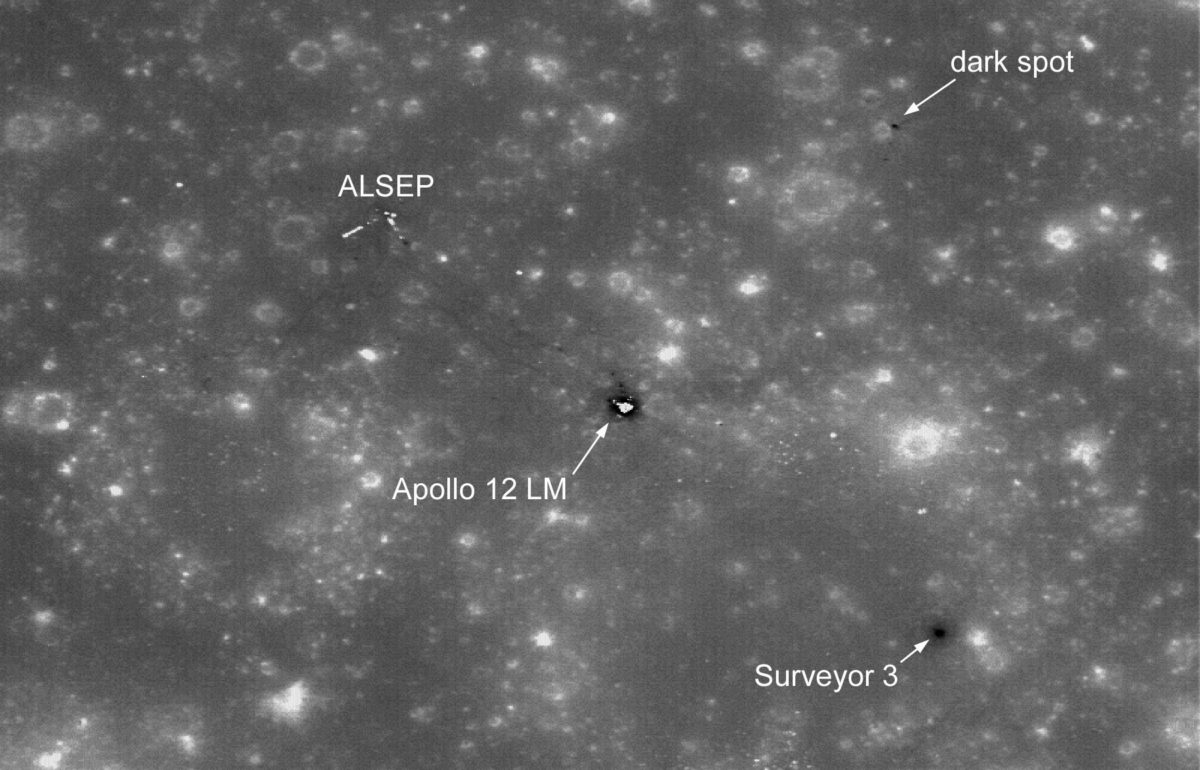Phil Stooke • Sep 15, 2015
Finding the Surveyor retro-rockets on the Moon
The Apollo landings on the Moon followed a series of robotic landings by NASA’s Surveyor spacecraft. Five of the seven Surveyors landed successfully between 1966 and 1968. Most of the Surveyors were sent to the three general regions where astronauts might land on the first few missions: close to the equator in the western, central, and eastern maria. Surveyor 1 was directed to the region in Oceanus Procellarum that allowed the simplest descent profile—a vertical descent from the approach trajectory. It landed safely, a few months after the Soviet Union had achieved the first lunar landing with Luna 9. Then Surveyor 2 was sent to Sinus Medii, the central landing region, but it failed during flight and crashed. Surveyor 3 landed safely in the western region, in a part of Oceanus Procellarum now referred to as Mare Insularum, the Sea of Islands. Surveyor 4 went back to Sinus Medii but failed during its final approach. Surveyor 5 landed safely in Mare Tranquillitatis, a bit off course but not too far from the eventual Apollo 11 landing site. Surveyor 6 finally achieved the goal of a landing in Sinus Medii, and with all three Apollo regions now certified safe, Surveyor 7 landed in the southern highlands near the crater Tycho on a purely scientific mission.
As the Surveyors reached the Moon, they were braked to near-zero velocity by a solid fuel retro-rocket mounted underneath the lander. The retro-rocket was ejected near the surface and fell to the ground, as three small rockets called verniers ignited to bring the lander safely to the ground. The process was not always uneventful. Surveyor 3’s verniers failed to cut off after landing and the vehicle bounced twice down the gentle slope of an old crater before ground controllers could turn them off. Surveyor 4 probably failed when one or more of its verniers failed to ignite.

This image shows the Apollo 12 landing area in a Lunar Reconnaissance Orbiter (LRO) image taken with the sun almost overhead. This rather unfamiliar lighting means we can’t see any shadows, so craters and rocks don’t show up well. But several dark spots are very obvious. One is the Apollo 12 Lunar Module whose base is still on the Moon. Another is Surveyor 3 itself. Surveyor was an open framework structure, and the spacecraft components cast shadows, which we can see through the gaps in the frame, so it looks dark. Disturbed soil looks dark as well, so astronaut tracks can be seen on the surface. Some bright markings reveal the reflective surfaces of parts of the ALSEP (Apollo Lunar Surface Experiment Package), equipment set out on the surface by the astronauts. But there’s an unexplained dark spot at upper right in the image. Could it be the Surveyor retro-rocket?
The panels above show that it probably is the retro-rocket. At left, a Lunar Orbiter image shows the area of that spot before Surveyor 3 landed. Next to it is an LRO image showing a dark spot that was not there in the earlier image. The light is coming from a different direction, but at a similar angle. Next, the high sun image shows the dark spot without shadows, and an enlargement shows a few other markings near it. It looks as if the rocket casing might have bounced or rolled, or perhaps the nozzle was thrown off it and made the smaller marks.

The image above shows a Surveyor spacecraft with the rocket casing in place. The casing is about 1 m (3 feet) across. Below is the best view of this object, taken when LRO dropped to a very low orbit for a short time. The dark spot is in a distinct crater, just a couple of meters across.
I noticed this spot in 2009 and presented it with other observations at the Lunar and Planetary Science Conference (LPSC) in 2010. But I always wondered if other retro-rockets might be found. Now I have what I think are good candidates for Surveyors 5 and 6. In both cases the high sun images help to locate the retro-rocket. The dark disturbed surface is easy to spot when there are no shadows. I’m not yet sure about Surveyor 1, and I have no idea about Surveyor 7 because the sun is never overhead at its latitude.
Both the Surveyor 5 and 6 landing sites have suggestions of a linear marking where a roll or bounce might have left a mark on the surface. These are quite good candidates for retro-rockets, but there is still some uncertainty. All the same, this shows that there are still things to look for on the Moon. In my mind the greatest find would be Luna 9, the Soviet Union’s first successful lander. But its location is quite uncertain and it would take a great deal of both luck and skill to find it.
Support our core enterprises
Your support powers our mission to explore worlds, find life, and defend Earth. You make all the difference when you make a gift. Give today!
Donate

 Explore Worlds
Explore Worlds Find Life
Find Life Defend Earth
Defend Earth





